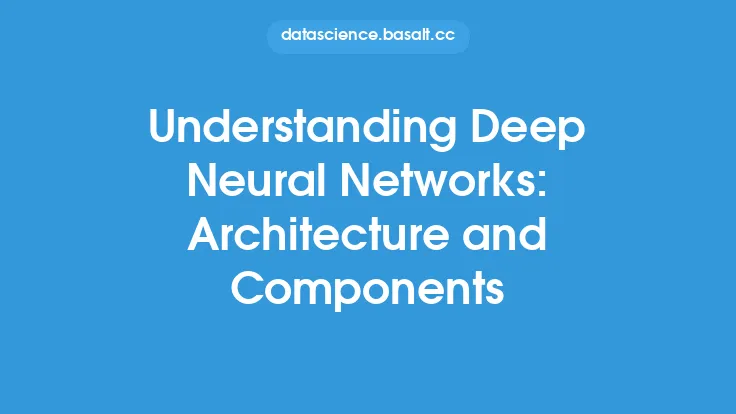Deep neural networks have revolutionized the field of machine learning, enabling state-of-the-art performance in a wide range of tasks, from image and speech recognition to natural language processing and game playing. At the heart of these networks are activation functions, which play a crucial role in introducing non-linearity into the model, allowing it to learn and represent complex relationships between inputs and outputs. In this article, we will delve into the world of activation functions, exploring their importance, types, and applications in deep neural networks.
Introduction to Activation Functions
Activation functions are mathematical functions that are applied to the output of each layer in a neural network, introducing non-linearity into the model. This is necessary because linear models are not capable of learning complex relationships between inputs and outputs. Without activation functions, a neural network would simply be a linear transformation of the input data, and would not be able to learn or represent non-linear relationships. The activation function takes the output of each layer, which is typically a linear combination of the inputs and weights, and maps it to a non-linear output. This non-linear output is then passed on to the next layer, where the process is repeated.
Types of Activation Functions
There are several types of activation functions that are commonly used in deep neural networks, each with its own strengths and weaknesses. Some of the most popular activation functions include:
- Sigmoid: The sigmoid function maps the input to a value between 0 and 1, and is often used in the output layer of binary classification models. However, it has been largely replaced by other activation functions due to its tendency to saturate, which can lead to vanishing gradients during backpropagation.
- Tanh: The tanh function is similar to the sigmoid function, but maps the input to a value between -1 and 1. It is less prone to saturation than the sigmoid function, but can still suffer from vanishing gradients.
- ReLU (Rectified Linear Unit): The ReLU function maps all negative values to 0, and all positive values to the same value. It is a popular choice for hidden layers, as it is computationally efficient and does not suffer from vanishing gradients. However, it can result in dying neurons, where a large number of neurons output 0 for a given input.
- Leaky ReLU: The leaky ReLU function is a variation of the ReLU function, where a small fraction of the input is allowed to pass through, even if it is negative. This helps to alleviate the problem of dying neurons.
- Swish: The swish function is a recently introduced activation function, which has been shown to outperform ReLU in some cases. It is defined as x * g(x), where g(x) is the sigmoid function.
- Softmax: The softmax function is often used in the output layer of multi-class classification models, as it maps the input to a probability distribution over all classes.
Properties of Activation Functions
When choosing an activation function, there are several properties that should be considered. These include:
- Non-linearity: The activation function should be non-linear, in order to introduce non-linearity into the model.
- Continuity: The activation function should be continuous, in order to ensure that the model is differentiable.
- Differentiability: The activation function should be differentiable, in order to enable backpropagation.
- Monotonicity: The activation function should be monotonically increasing, in order to ensure that the model is stable and easy to train.
- Computational efficiency: The activation function should be computationally efficient, in order to enable fast training and inference.
Applications of Activation Functions
Activation functions have a wide range of applications in deep neural networks, including:
- Image classification: Activation functions are used in the hidden layers of image classification models, such as convolutional neural networks (CNNs).
- Natural language processing: Activation functions are used in the hidden layers of natural language processing models, such as recurrent neural networks (RNNs) and transformers.
- Speech recognition: Activation functions are used in the hidden layers of speech recognition models, such as RNNs and CNNs.
- Game playing: Activation functions are used in the hidden layers of game playing models, such as alpha-go and alpha-zero.
Challenges and Limitations
While activation functions are a crucial component of deep neural networks, they also present several challenges and limitations. These include:
- Vanishing gradients: Some activation functions, such as the sigmoid and tanh functions, can suffer from vanishing gradients during backpropagation, which can make it difficult to train the model.
- Dying neurons: Some activation functions, such as the ReLU function, can result in dying neurons, where a large number of neurons output 0 for a given input.
- Saturation: Some activation functions, such as the sigmoid and tanh functions, can saturate, which can lead to vanishing gradients and make it difficult to train the model.
Future Directions
Despite the challenges and limitations of activation functions, they remain a crucial component of deep neural networks. Future research directions include:
- Developing new activation functions that are more efficient and effective than existing ones.
- Investigating the use of activation functions in different domains, such as reinforcement learning and generative models.
- Developing methods for automatically selecting the best activation function for a given task and model architecture.
Conclusion
In conclusion, activation functions play a crucial role in deep neural networks, introducing non-linearity into the model and enabling it to learn and represent complex relationships between inputs and outputs. While there are several types of activation functions, each with its own strengths and weaknesses, the choice of activation function depends on the specific task and model architecture. By understanding the properties and applications of activation functions, as well as the challenges and limitations they present, researchers and practitioners can develop more effective and efficient deep neural networks.





